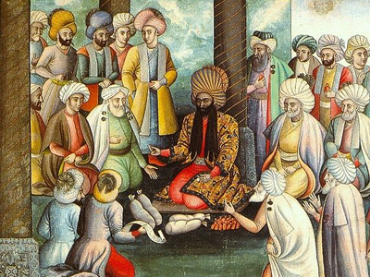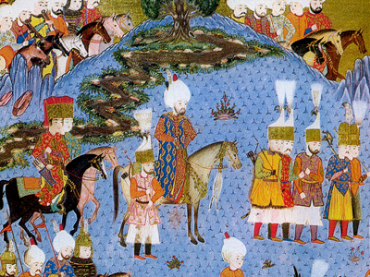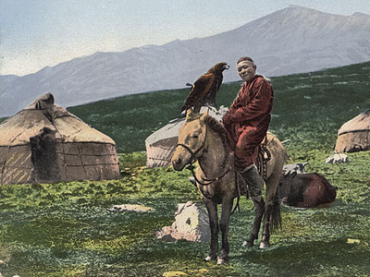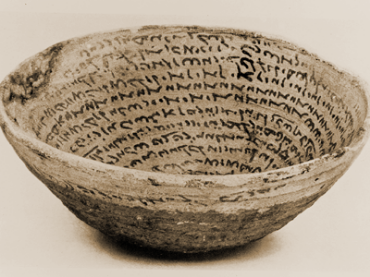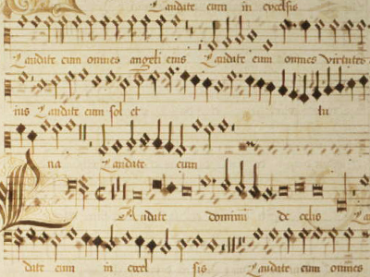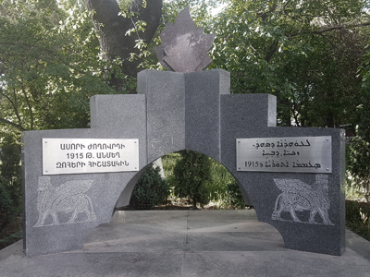History
The Moors in Spain
By Stanley Lane-Poole; In Collaboration With Arthur Gilman
Series: Kiraz Theological Archive 43
ISBN: 978-1-60724-320-5
Taking his interest in the Islamic conquest to its northwestern frontier, Lane-Pool here considers the history of the Moors in Spain. The famous battles and their various outcomes are recorded. A gripping account for students of history, this treatment of the Islamic presence in Europe is a solid piece of research that has stood the test of time.
$160.00
Études sur les Tchinghianés ou Bohémiens de l’Empire Ottoman
Series: Kiraz Historical Grammars Archive 19
ISBN: 978-1-60724-321-2
A rare exploration of the language of the Romani people (popularly called “gypsies”), this study has been the standard reference for those who wish to explore the still poorly understood languages of the Bohemians of the Ottoman Empire. Part language study, part translation exercise, Paspates’ treatment is one of the few available on this topic. Starting out with an introduction and brief grammar, the major portion of the book is a lexicon of Romani. A brief concluding chapter contains stories both in the original language and in French translation. A must-have title for students of Romani, this book is a useful addition to the Gorgias Historical Grammar series.
$249.00
Letters from Egypt
By Lucie Duff Gordon; Introduction by Diane Robinson-Dunn
Series: Cultures in Dialogue: Second Series 1
ISBN: 978-1-59333-909-8
Diagnosed with tuberculosis, Lady Lucie Duff Gordon left her family in London in 1862 to take up permanent residence in Upper Egypt or the Saeed. There she wrote Letters from Egypt (1865), which offers an intimate portrayal of the social life of the Saeed, connecting happenings there with international politics and issues around race, class, nation, and gender.
$190.00
In the Wake of Tikva Frymer-Kensky
Series: Gorgias Précis Portfolios 4
ISBN: 978-1-59333-977-7
This volume consists of 14 papers delivered by Assyriologists and biblical specialists at the 2007 Society of Biblical Literature congress in sessions devoted to the scholarly legacy of the late Tikva Frymer-Kensky, Professor of the Hebrew Bible at the Divinity School of the University of Chicago.
$148.00
Changing the Center of Gravity
Transforming Classical Studies Through Cyberinfrastructure
Edited by Melissa Terras & Gregory Crane
ISBN: 978-1-60724-881-1
The essays in this volume reflect a new generation of classicists hunting for new methods to understand and to disseminate ancient texts, both to increase the body of published information about classical Greek and Latin and also to encourage these languages to play an increased role in the intellectual life of humanity. In discussing areas as diverse as teaching, citation, criticism, collaboration, epigraphy, geography, grammar, lexicography, and digitization, this volume demonstrates the new scope and potential in Digital Classics research.
$202.00
Arabic Sources for Syriac Studies
By George Awwad
Series: Kiraz References Archive 5
ISBN: 978-1-60724-337-3
This comprehensive reference work provides bibliographical and manuscript data to Arabic works in the field of Syriac studies, both published and unpublished. The book contains over 2,000 subject and title entries.
$223.00
The Eucharist in Africa
Series: Kiraz Liturgical Studies 11
ISBN: 978-1-60724-362-5
An introduction to the issues surrounding inculturation, with particular reference to the Eucharist in the African context. Discussion is held of a variety of denominations and the text of the Eucharistic prayer for the new Kenyan service is included.
$138.00
Essays in Early Eastern Initiation
Edited by Paul Bradshaw
Series: Kiraz Liturgical Studies 12
ISBN: 978-1-60724-363-2
Paul Bradshaw, Maxwell Johnson, and Ruth Meyers write on baptismal practice in the Alexandrian tradition, reconciling Cyril and Egeria on the catechetical process, and the structure of the Syrian baptismal rite.
$110.00
The Missing Oblation'
The Contents of the Early Antiochene Anaphora
Edited by John Fenwick
Series: Kiraz Liturgical Studies 15
ISBN: 978-1-60724-366-3
This concise study considers the Anaphoras of the Apostles and the Liturgy of John Chrysostom. Also included is the relationship between these pieces and the Anaphora of the Apostolic Constitutions book viii.
$138.00
The Anglican Eucharist in New Zealand 1814-1989
By Bosco Peters
Series: Kiraz Liturgical Studies 23
ISBN: 978-1-60724-374-8
The background, beginnings, and controversies of the Eucharistic developments in New Zealand are presented. The twenieth century is divded into four periods to facilitate the exploration.
$138.00
Foundations of Christian Music
The Music of Pre-Constaninian Christianity
By Edward Foley
Series: Kiraz Liturgical Studies 24
ISBN: 978-1-60724-375-5
Taking a wider historical scope, this booklet examines the auditory environment and the temple of Herod as well as first century synagogues. Music in borrowed spaces and house churches of early Christianity conclude the study.
$142.00
Anglican Liturgical Inculturation in Africa
The Kanamai Statement 'African Culture and Anglican Liturgy'
Edited by David Gitari
Series: Kiraz Liturgical Studies 29
ISBN: 978-1-60724-380-9
With Introduction, Papers read at Kanamai, and a first Response.
$110.00
Ancient and Modern
Series: Kiraz Liturgical Studies 30
ISBN: 978-1-60724-381-6
An artful examination of the baptismal font and its place in ancient and modern Christianity. The basic concepts of water and baptism are also explored.
$139.00
The Comparative Liturgy of Anton Baumstark
By Fritz West
Series: Kiraz Liturgical Studies 31
ISBN: 978-1-60724-382-3
An homage to Anton Baumstack and his comparative liturgy. This brief study includes an intellectual biography and his method and comparative practice in regards to liturgy.
$138.00
Worship and Evangelism in Pre-Christendom
By Alan Kreider
Series: Kiraz Liturgical Studies 32
ISBN: 978-1-60724-383-0
This booklet explores the Christianity of the days before it became an official religion of the Roman Empire. It considers the impact of various areas of church life in this initial state.
$139.00
The Ritual Kiss in Early Christian Worship
Series: Kiraz Liturgical Studies 36
ISBN: 978-1-60724-387-8
This study collates the scattered evidence in the New Testament patristic literature for its practice, and examines its spiritual and quasi-sacramental significance, including its relation to the role of the Spirit.
$138.00
Coronations Past, Present and Future
Edited by Paul Bradshaw
Series: Kiraz Liturgical Studies 38
ISBN: 978-1-60724-389-2
Henry Everett, Paul Bradshaw and Colin Buchanan combine to provide a post-Reformation overview of the changes and tendencies in the English Coronation service, including an astringent look at the likely future needs.
$138.00
Anglican Missals and their Canons
1549, Interim Rite and Roman
By Mark Dalby
Series: Kiraz Liturgical Studies 41
ISBN: 978-1-60724-392-2
With the 1552 prayer book the weaponry of the earlier liturgical works changed. This booklet discusses the missals and canons up to the modern period.
$138.00
Baptism in Early Byzantine Palestine 325-451
By Juliette Day
Series: Kiraz Liturgical Studies 42
ISBN: 978-1-60724-393-9
Juliette Day read a fascinating paper on this subject at the SLS Conference in 1998, and has now turned it into a published Study. It is distinguished by her great care about issues of both topography and dating in relation to Palestine, and in the process she both corrects other scholars and gives a notable overview of a special period.
$138.00
Ambrosianum Mysterium
The Church of Milan and its liturgical tradtion
By Cesare Alzati; Translated by George Guiver & C.R.
Series: Kiraz Liturgical Studies 43
ISBN: 978-1-60724-394-6
The author is the Milanese expert on the Ambrosian rite and this (with Volume 2) makes available in English very important material previously unknown.
$138.00
The Eucharistic Doctrine of The Later Nonjurors
A Revisionist View of the 18th-Century Usages Controversy
By James Smith
Series: Kiraz Liturgical Studies 45
ISBN: 978-1-60724-396-0
The division between the 'Usagers' and the 'Non-Usagers' is fairly well known, but is here clarified and charted in detail but within a view of the overall non-juring situation.
$138.00
Offerings from Kenya to Anglicanism
Liturgical Texts and Contexts including 'A Kenyan Service of Holy Communion'
By Graham Kings & Geoff Morgan
Series: Kiraz Liturgical Studies 48
ISBN: 978-1-60724-399-1
The 1989 Kenyan eucharistic text has had much publicity, including its use at the opening service of the 1998 Lambeth Conference, but has had little in the way of introduction or commentary. These two authors, with much Kenyan experience and with encouragement from the key persons in Kenya, here provide the text with a valuable contextual exposition.
$138.00
Early Jewish Liturgy
A Sourcebook for use by students of Early Christian Liturgy
Series: Kiraz Liturgical Studies 49
ISBN: 978-1-60724-400-4
Whereas many studies suggest or presuppose some link between Christian liturgical origins and the practices of Judaism the Jewish sources are hard to find and understand for Christian students without any background in early Judaism and its literature. This book presents some of the relevant sources in clear English, with accompanying material which sets the sources in their context and introduces the student to the debate about the relationship between Jewish and early Christian liturgy.
$110.00
Church and Worship in Fifth-Century Rome
The Letter of Innocent 1 to Decentius of Gubbio
Series: Kiraz Liturgical Studies 50
ISBN: 978-1-60724-401-1
The letter comes from the fourth century and is therefore very significant for studies of early Roman liturgical history - and is frequently quoted. Here the series provides the full text with translation and notes.
$138.00
The Savoy Conference Revisited
The proceedings taken from the Grand Debate of 1661 and the works of Richard Baxter
Edited with an Introduction by Colin Buchanan
Series: Kiraz Liturgical Studies 52
ISBN: 978-1-60724-403-5
The records of the Savoy Conference come from seventeenth century sources, and they were edited and reproduced in two nineteenth century volumes: E.Cardwell's A History of Conferences and Other Proceedings connected with the Revision of The Book of Common Prayer; from the year 1558 to the year 1690 (1841, and 2nd ed. 1849) and G.Gould, Documents relating to the Settlement of the Church of England by the Act of Uniformity of 1662 (London, 1862). Both present the Presbyterians' 'Exceptions' tabled at the Savoy Conference in 1661, and the Bishops' (somewhat unyielding) Answers to the Exceptions - but neither editor brings the texts together. This Joint Study presents the General Exceptions in parallel column with their respective Answers.
$140.00
Filter by
Filter by price
Filter by manufacturer

